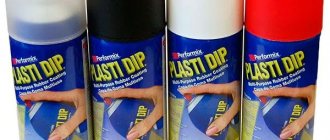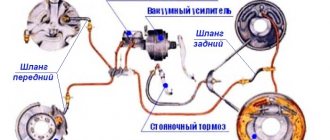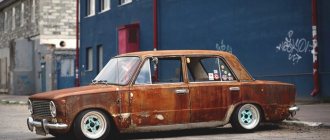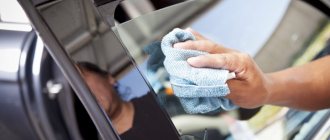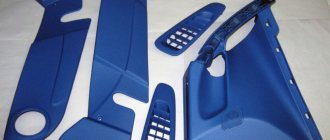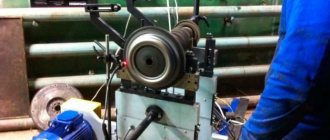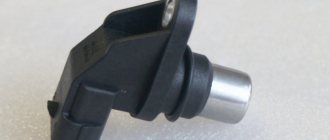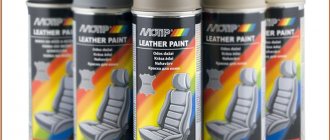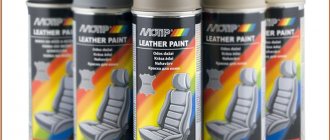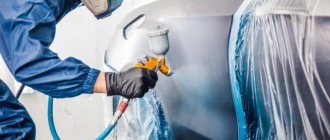In this article we will take a closer look at how interior plastic is painted.
Painting the interior plastic allows you to transform the plain interior of your car, giving it individuality. You can paint both individual elements and entire panels. This also solves the problem of plastic faded by time and sun.
When painting interior plastic, you need to follow some rules so that the paint holds tightly and does not begin to peel off during subsequent use.
Content:
- What is required to paint interior plastic?
- What paint should I use on the interior plastic?
- What color should I paint the interior plastic?
- What kind of plastic is used in the car interior?
- Adhesion promoter
- Preparing plastic for painting
- Coloring
What is required to paint interior plastic?
- Buy gloves and a respirator.
- Sanding paper P400, P600, P800
- Gray Scotch-Brite
- You can also purchase a special sticky wipe. She needs to wipe the surface before painting and during painting, between layers. It collects dust well and does not leave lint.
- Adhesion promoter (primer for plastic)
- Plain soil (optional)
- Dye. The amount of paint needed depends on the area of the elements you want to paint.
- Varnish (optional)
What paint should I use on the interior plastic?
- There is paint designed for plastic. Vinyl paint/dye is suitable for painting car interiors. This paint can also be sold as interior leather paint. In this case, on the can, when listing the surfaces to be painted, “dash panel” may be indicated. Vinyl paint is water-soluble and contains vinyl plastic (PVC) that adheres well to plastic surfaces. Once painted, the paint becomes part of the plastic surface. There are different formulas of this paint designed for specific tasks. Some manufacturers still recommend applying even this paint only after spraying plastic primer (for maximum adhesion).
- In addition to special vinyl paint, car paint can be used to paint plastic interior parts, either in cans or sprayed through a spray gun. A prerequisite will be the spraying of a special plastic primer (adhesion enhancer). We will consider this soil and its application in more detail in this article below. The paint can be selected at an auto enamel store according to the interior color (on modern cars there is a plate with the interior color code).
- If you plan to paint the interior panels, then use a non-glossy paint so that it matches the rest of the interior parts. Glossy paint on large parts (or the entire dashboard) will look cheap and can also create glare that will distract from driving. However, individual small elements may well be glossy and will harmonize well with the rest of the matte part of the interior.
- It is necessary to use paint and varnish on the same base and not mix different types of paintwork, otherwise defects may occur due to incompatibility of the products. Find a manufacturer that offers the full line of products needed to paint interior plastic. This is a special plastic primer, acrylic primer (optional), paint and varnish (optional).
Let's talk about varieties
Modern car enthusiasts who prefer to paint the interior themselves most often use the following types of paints:
- Acrylic paste. Automotive acrylic paste is widely used for painting leather upholstery and chairs. This material is convenient because after applying it to the work surface, abrasions, small scratches and other defects completely disappear. It is easily applied using gauze swabs or a special brush, and dries completely in literally 10-12 hours.
- Acrylic cream. This material is also used for dyeing leather, however, unlike paste, it gives a more saturated and lasting color. Acrylic cream is highly resistant to abrasion and can retain its original shade for 5-10 years, depending on how carefully the driver treats his car. It is ideal for eliminating visual defects in leather steering wheel upholstery and does not cause any specific odors inside the car.
- Two-component varnish. Most often, this type of paint and varnish is used for the front panel and other plastic elements that often come into contact with fingers. It dries much longer than cream or paste, but in terms of reliability and wear resistance, the varnish is noticeably superior to all similar materials.
- Aerosols. Aerosol cans are the most convenient and practical to use. They can be used with equal success to restore the color of velor, leather upholstery, dashboards and other elements of a car’s interior. The only thing that needs to be taken into account is that a jet of dye from a spray can, if handled carelessly, can get on parts that do not need painting. Therefore, before you start painting the dashboard, front panel, leather upholstery of the steering wheel or seats using an aerosol, you need to protect all other elements from accidental contact with the material.
What color should I paint the interior plastic?
The choice of interior color or its individual elements is a matter of preference. Here are some recommendations, taking into account some body colors, that you can take into account when buying paint.
- For individual interior elements, colors such as silver, bronze, black, gray, chrome and gold are well suited. They can be considered universal for any car interior and exterior color.
- For red cars, red is a good color for the interior plastic inserts.
- On blue cars: individual parts of the interior can be painted in the same color as the body, blue with a mixture of purple, violet or orange.
- On black cars: universal colors, red, blue (cyan), purple, orange and pink (for girls).
- You should not choose a color that is too light (especially white) for painting interior parts, as it will be too easily soiled.
What kind of plastic is used in the car interior?
Inside the car, various parts can be made of different types of plastic. The most commonly used plastics in the interior are ABS, PC/ABS, PVC, PP, TPO, TPE, HIPS and their mixtures (see the article “Types of automotive plastics”).
The problem with painting plastics is that different plastics can have different surface properties (surface tension, flexibility) which can prevent the paint from adhering well. Some types of plastics can be painted without a special primer, after pre-treating the surface with abrasive materials and degreasing. Others require the use of a special primer (adhesion promoter). To determine the type of plastic, various tests can be used to apply the correct coloring process to the plastic part.
The result of improper preparation of the plastic surface and failure to use an adhesion promoter.
Most modern adhesion promoters (primer for plastic) are designed for use on any type of plastic, even those that do not require the application of such a primer. A special adhesion promoter primer can be applied to flexible or rigid plastics and fiberglass. It is important that the surface is clean.
Let's sum it up
There are many ways to restore the appearance of your car's interior. Various methods can be used and should be tested on scrap materials. If this is your first time painting, you should look at the instructions and find out the opinions of experts on working with a particular tool. It’s easy enough to understand how to properly paint plastic parts. Preparing and applying paint is a purely technical process.
But if you make mistakes in the process, you can make the result not the best quality. In this case, it is better to trust the specialists and overpay for the service. If you want a good result, use the highest quality solutions. In pursuit of low prices for materials and quick completion of work, you can simply destroy some interior parts and buy them new for a lot of money. In any situation, you should focus on high quality, in which case you will definitely succeed.
Adhesion promoter
- An adhesion promoter or plastic primer acts as an intermediary between plastic and paint and improves adhesion. A strong bond is formed between the paint and varnish material and the plastic.
- The adhesion promoter is a one-component chemical composition. Its use eliminates the need to identify the type of plastic in order to properly prepare it for painting.
- The formula of the adhesion enhancer may vary from manufacturer to manufacturer. The basis of such primers are strong solvents that “open the pores” on the plastic surface for better spreading and adhesion of paint. An adhesion promoter not only changes the surface properties of the plastic, but its additives can act as a glue between the plastic and the paint.
- The adhesion enhancer (primer for plastic) should be sprayed at a distance of 30 cm from the surface. Apply a thin layer. Spraying too much of an adhesion promoter can, on the contrary, cause problems with paint adhesion.
- It is always best to research how to apply an adhesion promoter to containers.
- The duration of action of special primers that increase adhesion may vary. Some manufacturers even guarantee action for 24 hours after application.
Varnishing
For varnishing plastic in a car, acrylic one- or two-component urethane varnish is most often used, which protects the surface from all kinds of mechanical damage and UV radiation. The varnish can be glossy, semi-gloss and matte. To obtain a glossy shine, the varnished surface can be polished with a terry towel after polymerization of the coating. It is recommended to apply the varnish 30 minutes after the last coat of paint.
The consistency of the varnish is watery, so it should be applied in a thin layer. In areas of most frequent human contact, several layers can be applied. The period of complete drying of the varnish is quite long, but this is compensated by the increased wear resistance of the varnished surfaces. After the interior and painted elements have completely dried, it is important to install the removed parts and return the car to its original appearance.
Recommended reading:
- How to paint a car metallic: step-by-step instructions, recommendations
- Local car painting - what is needed for this
- How to paint a car steering wheel and how to do it yourself
- How to paint a car chameleon color
Preparing plastic for painting
- The most important step in painting interior plastic is its preparation. There is no need to save time at this stage.
- It is better to dismantle the plastic parts that you want to paint. Remove the parts very carefully so as not to break anything. Failure of fasteners can cause painted panels to squeak or vibrate while the vehicle is in motion. It is better to find and study information about the correct removal of parts in advance. Some plastic elements are attached with self-tapping screws, some with clips, and some only with built-in latches on the fasteners.
- The parts need to be thoroughly cleaned. The purpose of a thorough wash is to remove any protective coatings or contaminants that could impair adhesion.
Scotch-Brite has abrasive fibers and is well suited for treating the textured surface of plastic parts.
- Clean the part with soapy water and gray Scotch-Brite. Use Scotch Brite to carefully work all the contours of the part, paying attention to the indentations, so that the entire surface is treated. When sanding plastic with Scotch Brite, be careful not to apply too much pressure. Deep scratches can be clearly visible on the plastic after painting.
- Gray Scotch Brite works well on structural plastic. It matts each recess well between the plastic grains and does not erase the grains, as sanding paper can do.
- To thoroughly clean hard-to-reach places (for example, ventilation grilles), you can use a toothbrush.
- For a deeper cleaning of plastic, you can use trisodium phosphate (a technical degreaser). Use gloves and a respirator, work in a ventilated area. Next, rinse and dry the washed plastic.
- To clean plastic from protective coatings and any silicones that affect further adhesion, you can also prepare a mixture of technical and ammonia alcohol (50/50). This composition works well for cleaning any plastic.
- As a result, the surface should become matte and non-sticky.
- Examine the condition of the parts to be painted for damage. If you find any damage, such as nicks or scratches, you will need to sand down the protruding plastic with P400 sanding paper. If you want to preserve the texture, sand only the protruding part and not the entire surface.
- If you want a smooth, glossy surface after painting, you can sand the entire surface with P320-P400 sanding paper. Then you need to apply an adhesion promoter (plastic primer), and then acrylic primer, dry and sand it before painting with P800 sanding paper. If you want to keep the original texture, skip this step.
- Degrease the surface. For degreasing, you can use isopropyl alcohol or a special degreaser.
- Wipe with a lint-free cloth in one direction (this is better for removing dirt).
- If some areas will not be painted, you can mask them with masking tape and covering material.
Necessary equipment, consumables
For painting work to transform a car dealership you will need:
- Tools for dismantling interior elements - screwdrivers, keys, steel forks, plastic spatulas, etc.
- Personal protective equipment: overalls, goggles, gloves, respirator.
- Cleaning equipment: rags, brushes, vacuum cleaner, chemicals for rust removal.
- Newspapers, rags, film, oilcloth, masking tape - to protect car parts that will not be painted.
- Grinding machine and sandpaper of varying degrees of grit: for cleaning corrosion, grinding and matting the surface.
- Solvent. Necessary for removing excess paint and degreasing surfaces.
- Putty for eliminating unevenness on plastic.
- A universal primer or specifically for plastic.
- Gel-plasticizer, necessary for processing textured surfaces.
- Spray gun, paint brushes.
- Paint for plastic. If you plan to paint the entire interior, you will need at least two cylinders.
- Urethane varnish designed to protect interior elements from rapid wear.
So, it is quite possible to carry out restoration of the car interior without the help of professionals. The main thing is to take the work seriously, calculate the costs and follow the instructions. Thus, you will save money, time, and also gain invaluable experience and decent results!
Source:
